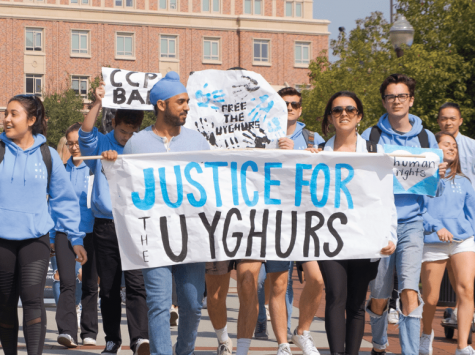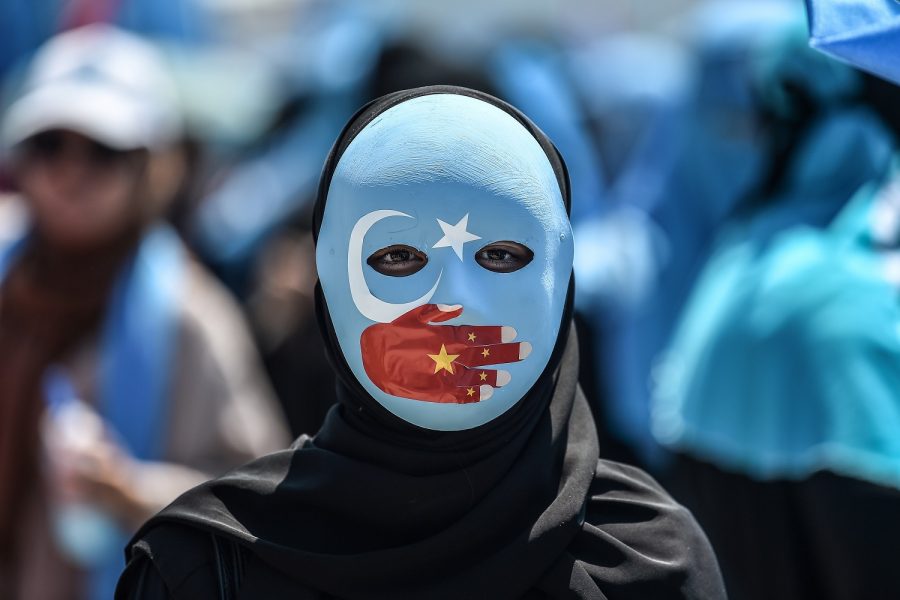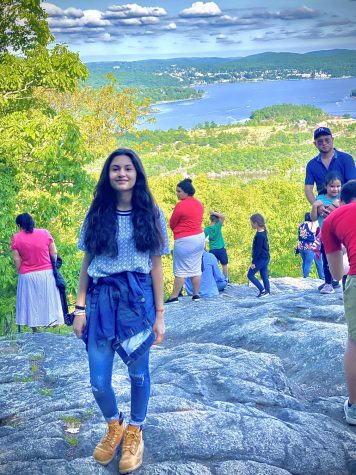China’s Hidden Internment Camps
TOPSHOT – A demonstrator wearing a mask painted with the colours of the flag of East Turkestan and a hand bearing the colours of the Chinese flag attends a protest of supporters of the mostly Muslim Uighur minority and Turkish nationalists to denounce China’s treatment of ethnic Uighur Muslims during a deadly riot in July 2009 in Urumqi, in front of the Chinese consulate in Istanbul, on July 5, 2018. – Nearly 200 people died during a series of violent riots that broke out on July 5, 2009 over several days in Urumqi, the capital city of the Xinjiang Uyghur Autonomous Region, in northwestern China, between Uyghurs and Han people. (Photo by OZAN KOSE / AFP) (Photo credit should read OZAN KOSE/AFP/Getty Images)
November 20, 2020
Sanjana Soni and Claudelle Cortez November 9 2020
Recently, news about Muslims being held captive in Chinese concentration camps has been leaked to the public by reporters. Such camps are designed to avoid the spreading of religious ideas by radical Muslims in China. About a million or more Uighurs, which are a group of Islamic Turkic-speaking people originating from the general region of Central and East Asia, have been detained in internment camps located in China’s Xinjiang region. While these camps are designed to restrain radical ideas, Uighurs are described to be the opposite.  They are a peaceful minority group that are not radical Islamists, in reality these camps are trying to diminish the Uighur identity. With Uighurs, many other Muslim minority groups are also believed to be located in similar regions. According to Chinese government officials, the groups are technically in “transformation camps” that were built to prevent extremism from spreading. However, reports indicate they are more like prisons. The watch towers, double-locked doors and video surveillance in the Chinese camps are there “to prevent escapes”. Muslim minorities are being scored on their ability to speak the Mandarin, China’s dominant language, to determine if they need to be in these camps. They follow strict rules on everything down to bathing. This all started after the 9/11 attacks in the United States, Chinese officials began justifying harsh security measures and religious restrictions arguing that young Uighurs were susceptible to the influences of Islamic extremism. Many Uighur exiles have stated that the Chinese government’s treatment of the Muslims are comparable to the treatment of Jewish people by Germany’s government during the Holocaust. A group of watchdog groups and experts issued a joint letter that said China’s policies in Xinjiang “meet the threshold of acts constitutive of genocide,” a crime brought into international law after World War II. The Chinese government has angrily rejected such claims while continuing the growth of detention sites across Xinjiang. To spread awareness look at the Change.org website below and sign the petition to be a part of the change in the world.
They are a peaceful minority group that are not radical Islamists, in reality these camps are trying to diminish the Uighur identity. With Uighurs, many other Muslim minority groups are also believed to be located in similar regions. According to Chinese government officials, the groups are technically in “transformation camps” that were built to prevent extremism from spreading. However, reports indicate they are more like prisons. The watch towers, double-locked doors and video surveillance in the Chinese camps are there “to prevent escapes”. Muslim minorities are being scored on their ability to speak the Mandarin, China’s dominant language, to determine if they need to be in these camps. They follow strict rules on everything down to bathing. This all started after the 9/11 attacks in the United States, Chinese officials began justifying harsh security measures and religious restrictions arguing that young Uighurs were susceptible to the influences of Islamic extremism. Many Uighur exiles have stated that the Chinese government’s treatment of the Muslims are comparable to the treatment of Jewish people by Germany’s government during the Holocaust. A group of watchdog groups and experts issued a joint letter that said China’s policies in Xinjiang “meet the threshold of acts constitutive of genocide,” a crime brought into international law after World War II. The Chinese government has angrily rejected such claims while continuing the growth of detention sites across Xinjiang. To spread awareness look at the Change.org website below and sign the petition to be a part of the change in the world.
Work Cited:
Buckley, Chris, and Austin Ramzy. “Night Images Reveal Many New Detention Sites in China’s Xinjiang Region.” The New York Times, The New York Times, 24 Sept. 2020,
www.nytimes.com/2020/09/24/world/asia/china-muslims-xinjiang-detention.html.
Press, The Associated. “Secret Documents Reveal How China Mass Detention Camps Work.” AP NEWS, Associated Press, 25 Nov. 2019,
apnews.com/article/4ab0b341a4ec4e648423f2ec47ea5c47.
Schmitz, Rob. “Reporter’s Notebook: Uighurs Held For ‘Extremist Thoughts’ They Didn’t Know They Had.” NPR, NPR, 7 May 2019,
www.npr.org/2019/05/07/720608802/reporters-notebook-uighurs-held-for-extremist-thoughts-they-didnt-know-they-had.



